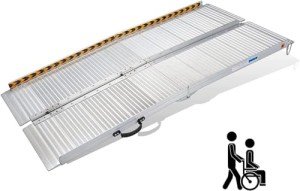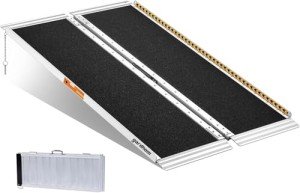
Mobile Ramps
Add a review FollowOverview
-
Founded Date December 9, 1966
-
Sectors Health Care
-
Posted Jobs 0
-
Viewed 11
Company Description
10 Tips For Mobility Ramps That Are Unexpected
Mobility Ramps for Homes: Enhancing Accessibility and Independence
As society continues to progress towards inclusivity and availability, mobility ramps have ended up being vital fixtures in lots of homes. These ramps not just supply a way of entry for individuals with mobility difficulties however likewise promote independence, security, and convenience. This article digs into the different elements of Mobility Ramps For Home ramps for homes, guiding homeowners through their types, advantages, setup factors to consider, maintenance, and regularly asked concerns.

Understanding Mobility Ramps
Mobility Ramps For Home ramps are developed to facilitate the motion of people utilizing wheelchairs, scooters, or other mobility aids. They enable simpler Wheelchair Access Ramp to homes, garages, and exit points without the need for substantial physical exertion or help.
Secret Benefits of Mobility Ramps
-
Independence: Mobility Scooter Ramps ramps empower people to enter and exit their homes without depending on help, cultivating a sense of independence.
-
Safety: An appropriate ramp reduces the danger of falls and injuries that can happen when navigating stairs.
-
Flexibility: These ramps can be built for different environments and can be temporary or permanent options.
-
Home Value: Installing a mobility ramp can increase the general worth of a home as it promotes inclusivity.
-
Reduce of Use: Designed for a range of mobility levels, ramps accommodate wheelchairs, walkers, and individuals with restricted mobility.
Kinds Of Mobility Ramps
Picking the best mobility ramp depends on particular needs, physical space, and budget plan. Here’s an in-depth contrast of common kinds of mobility ramps:
| Ramp For Wheelchair Type | Description | Pros | Cons |
|---|---|---|---|
| Portable Ramps | Lightweight, easily portable ramps, frequently made from aluminum. | Easy to keep and move, perfect for temporary needs. | Restricted weight capacity, might not be appropriate for permanent use. |
| Threshold Ramps | Brief ramps created to bridge entryways or entrances. | Simple setup, beneficial for little height distinctions. | Not ideal for larger stairs or steep inclines. |
| Irreversible Ramps | Built from wood, aluminum, or concrete, these ramps are implied for long-lasting usage. | Sturdy and resilient, personalized to different lengths and heights. | More pricey and may need planning/building authorizations. |
| Folding Ramps | Ramps that can fold for simple transportation or storage. | Storable and helpful for numerous usages. | Possibly less stable than permanent options. |
| Modular Ramps | Pre-fabricated areas that can be assembled to create a custom ramp design. | Easy to set up and reorganize, versatile to different spaces. | May have a greater upfront cost compared to other ramps. |
Installation Considerations
Prior to including a mobility ramp to a home, a number of aspects require to be thought about to guarantee optimum performance and security:
-
Space Assessment: Measure the location where the ramp will be installed, accounting for existing structures and paths.
-
Building regulations: Familiarize yourself with regional building codes and policies to make sure compliance, particularly for permanent ramps.
-
Slope Ratio: The Americans with Disabilities Act (ADA) suggests a slope ratio of 1:12 for wheelchairs. This indicates for every single inch of vertical increase, there ought to be at least 12 inches of ramp run.
-
Product Selection: Choose a material that is resilient and weather-resistant to extend the ramp’s life-span.
-
Surface area Texture: Ensure the ramp has a non-slip surface area to reduce the risk of accidents, especially in inclement weather condition.
-
Handrails: Consider installing hand rails for additional support, especially on longer ramps or those with steeper inclines.
Upkeep of Mobility Ramps
Keeping mobility ramps is necessary for ensuring safety and durability. Here are some ideas:
-
Regular Inspections: Inspect the ramp regularly for damage, wear, or loose bolts that might affect stability.
-
Cleaning: Keep the ramp clear of particles, such as leaves and snow, to prevent slipping hazards.
-
Surface area Repair: Address any surface area concerns, such as splitting or splintering, in wooden ramps immediately.
-
Repaint if Necessary: For Metal Ramp For Wheelchair ramps, repainting can help prevent rust and deterioration.
-
Inspect Handrails: Ensure handrails are firmly attached and can support weight when needed.
Often Asked Questions (FAQ)
1. Do I need a license to set up a mobility ramp?
Yes, depending upon local policies, a license might be required, particularly for irreversible ramps. It’s recommended to contact your local building authority.
2. How much does a mobility ramp cost?
The cost of mobility ramps varies extensively based on the type, products, and setup requirements. Portable ramps can start at a couple of hundred dollars, while permanent ramps can vary from ₤ 1,000 to ₤ 5,000 or more.
3. Can I set up a ramp myself?
While some portable ramps are easy to set up, permanent ramps often need professional installation to guarantee security and compliance with structure codes.
4. How do I figure out the ideal slope for my ramp?
Follow the ADA guidelines of a 1:12 slope ratio for wheelchairs. Furthermore, consider the specific needs of the user and the area available.
5. What materials are best for outdoor ramps?
Aluminum, treated wood, and concrete are popular options for outdoor ramps due to their toughness and resistance to weather conditions.
6. Are there insurance coverage advantages for setting up mobility ramps?
Some insurance plan might cover mobility adjustments, including ramps. Constantly inspect with your insurance provider for coverage information.
In conclusion, mobility ramps represent a crucial component of home ease of access, cultivating self-reliance, security, and inclusiveness. By comprehending the various types offered, considering installation requirements, keeping them efficiently, and looking for answers to common concerns, property owners can ensure a supportive environment for those with mobility difficulties. Making the best options relating to mobility ramps can substantially boost the lifestyle for people and their families.



